The Irish physically dominated a talented Clemson team with playoff aspirations, running at will and shutting down the Tiger offense. There’s already been some efforts to discount the resounding win – as if Clemson was never a real contender, or Notre Dame might not have dominated without a special teams and defensive score. But Dabo Swinney’s group is still a top-10 caliber team, with an offense that despite inconsistent QB play is 31st in Offensive F+.
Marcus Freeman’s team just dominated the matchups, strength on strength. Clemson’s rushing attack had been strong, but the Tigers barely tried rushing the ball between the tackles and were inefficient on the ground. The Tigers offense had been terrific generating long passing plays but couldn’t convert a throw of over 20 yards in South Bend until they were down 28-0. The secondary was supposed to be the weakness of this Clemson team, but Tommy Rees and the offense ran the ball all over the visitors instead.
This game technically went in and out of garbage time during the 4th quarter (defined as a lead of 23 points or more). I erred on the side of including all plays, which enhances the Irish offense (6.6 YPP after going up 28-0) and dilutes the defense (6.6 YPP allowed after allowing just 3.2 before the Morrison pick-six).
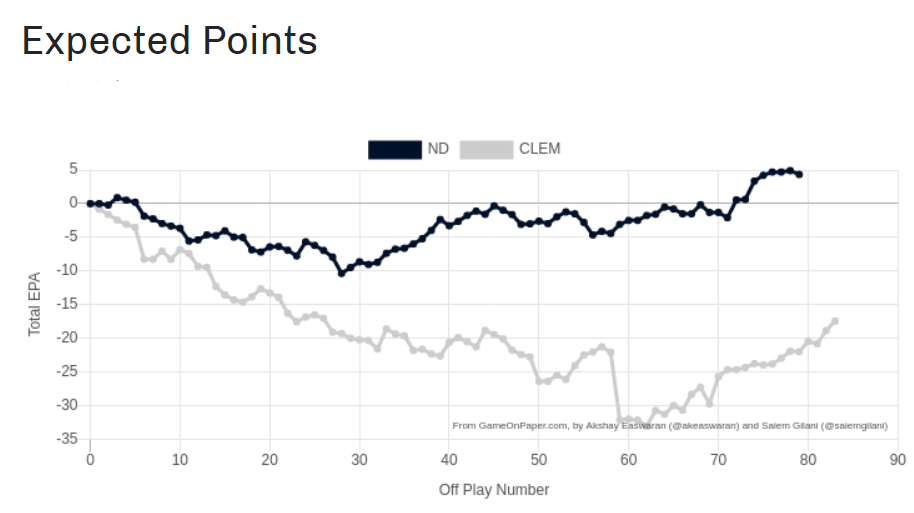
Stats from a few excellent sources – College Football Data, Game On Paper, and often referencing SP+ and FEI numbers. If you get lost, check out this handy advanced stats glossary here or reach out in the comments.
Not sustainable? Guess again
The consensus (including yours truly) was that the Syracuse formula would never work against this talented Clemson roster. The Irish would need to get more from the passing game, find more explosiveness, and replicate the special teams and turnover magic the best they could. Despite some cracks in the Tigers defensive foundation, it never seemed likely the team that struggled to impose its will on Stanford a few weeks ago would be able to run the ball consistently on a front loaded with future NFL talent.
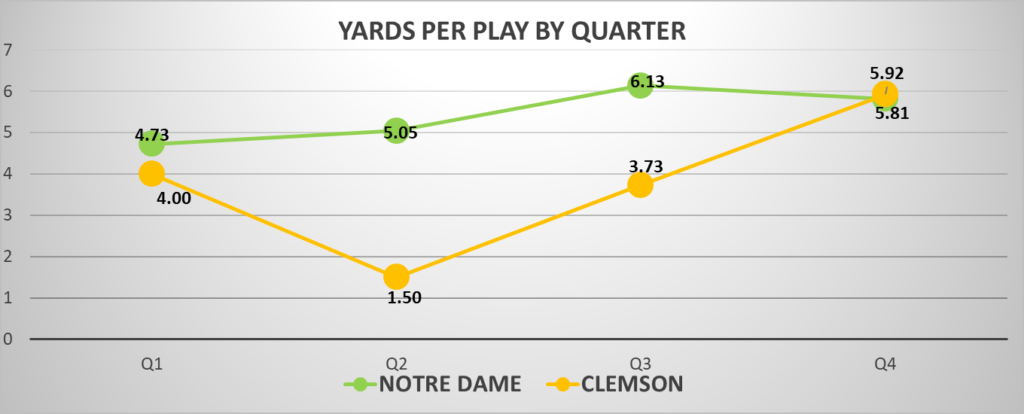
Marcus Freeman’s team then proceeded to do the same things that fueled the win in Syracuse, only better, especially considering the degree of difficulty and stakes. Special teams grabbed the early lead and set the tone for the evening, helping fuel another massive advantage in field position (+19 yards per possession). The longest Irish gain was only 20 yards and passes averaged only 4.7 yards per dropback. But it didn’t matter, as the rushing attack dominated with nearly a 60% success rate and 5.9 yards per carry despite running on 77% of early downs.
Defensive dominance gave the offense breathing room
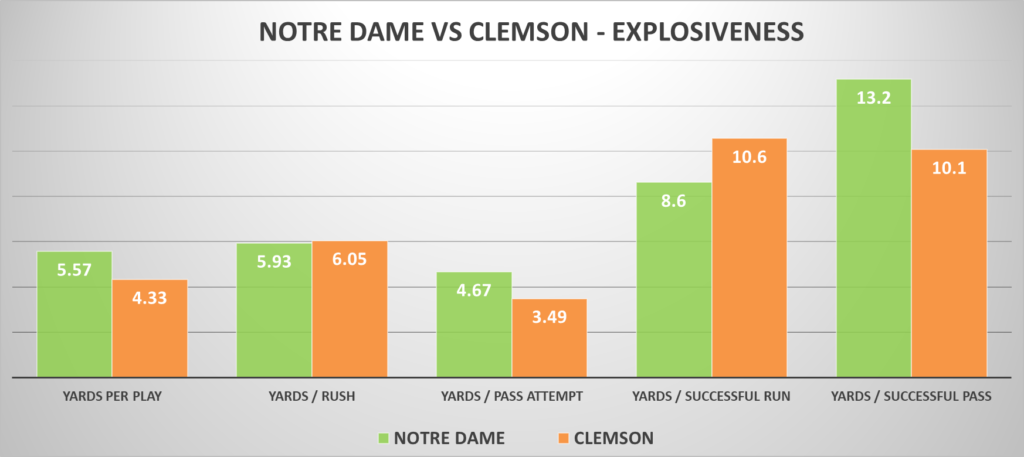
The late Clemson scoring drives diluted the overall numbers, but Al Golden’s defense kept firm control after being spotted an early lead. The Tigers didn’t have a scoring opportunity (1st down inside the Irish 40) until down 28-0 in the 4th quarter. At that point, with the game out of reach, the average Clemson drive was 4.2 plays in length (not counting punts) and 13.7 yards. At one point in the telecast Jason Garrett, ever the optimist, said something like “This is promising, they look in more of a rhythm now and I think it’s their best drive so far”. Clemson was at their own 31.
In the first half, Notre Dame held the Tigers to 0% success on passing downs, and 7.1% passing success. Their average 3rd down distance to gain was 14 yards! The misleading stat of the game may be Clemson’s rushing numbers – the final box score has the Tigers at a little over 6 yards per attempt with decent efficiency. But before Dabo’s team went down 28, Clemson was at a 29% rushing success rate, and the visitors virtually abandoned the run early on (36.5% early down run rate). FEI, which classifies the last 13 minutes after Clemson went down 28-0 as garbage time, has this as a better defensive performance in terms of available yards allowed than Georgia’s dominant season opening game in 2021.
What a beautiful thing to see the defense living up to their full potential, with all the pieces working in harmony. The defensive line and pass rush were tenacious, the linebackers played their best game in the year (after doing the same last week), and Benjamin Morrison and the secondary blanketed the deep shots Clemson loves.
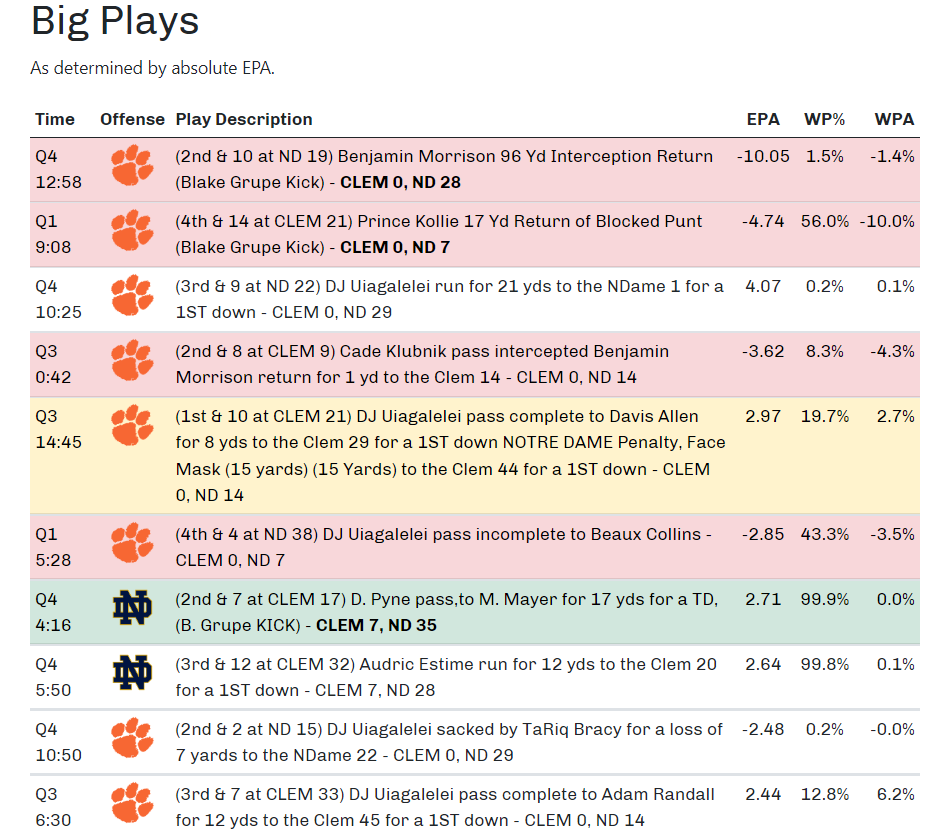
Expected points added (EPA) isn’t an exact science, but using it’s calculations Morrison’s interceptions were worth roughly two touchdowns, which checks out! The pick-six is worth so much more above because of the field position dynamics – Clemson is in a place where they’re expected to add significant points, making it worth more than the blocked punt or first interception where already the Tigers are in a negative EPA situation (Notre Dame more likely to score next).
Building the offense around run efficiency
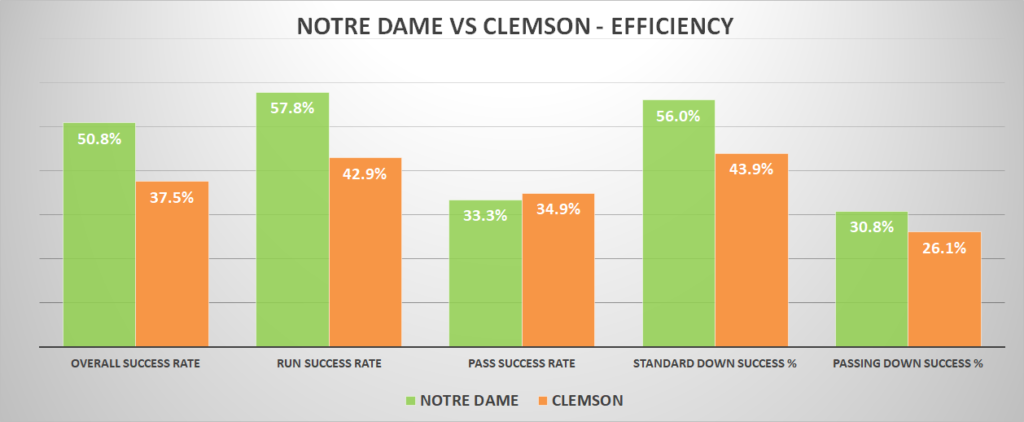
It’s extremely fun to win with explosiveness – the 2015 offense will always have a special place in my heart – but this game reminds you why segments of the ND fanbase have such an obsession with running the ball. It was an incredible revelation that slowly unveiled itself to fans and probably players over the course of the game – from “ND is running it decently” to “hold on, they’re really getting some push here” to finally “they can’t stop us, even when they know it’s coming”. The Irish offensive line bullied Clemson throughout, grinding them down run after run and not allowing any disruption (one sack lost one yard; only three run stuffs on 45 ND runs).
The running backs deserve immense credit along with the line. Estime and Diggs were special in their balance, vision, and ability to maximize yards despite not breaking out for super long gains. It feels long only a matter of time before a couple of these runs get loose, but the rushing efficiency is morphing into the bedrock of the offense. Over the last two weeks Estime runs have had a 68.4% success rate. For context, Oregon leads the nation by a good margin with a 61.2% run success rate, so lately Estime runs are well above the efficiency levels of the best in the country.
Can Tommy grow the passing game before USC?
Drew Pyne did not return to his magic Carolina or Vegas form, and was smartly not asked to do much (4.7 yards per dropback on 18 plays). But he navigated the pressure-packed game well, made some plays with his legs, and unlike his counterparts in white and orange didn’t make costly mistakes. Ideally Navy and BC afford some opportunities to let Pyne stretch his wings a bit more and find repeatable plays that can work downfield, but if the rushing game can be this dominant it will benefit the QB too.
But zero third down conversions passing the football means there’s still significant work to be done. It’s terrific that the Irish were able to limit havoc and string together long drives, but right now it’s an offense that’s easily foiled. It only takes one penalty, negative play, or calculated risk that doesn’t work for a Notre Dame drive to stall out.
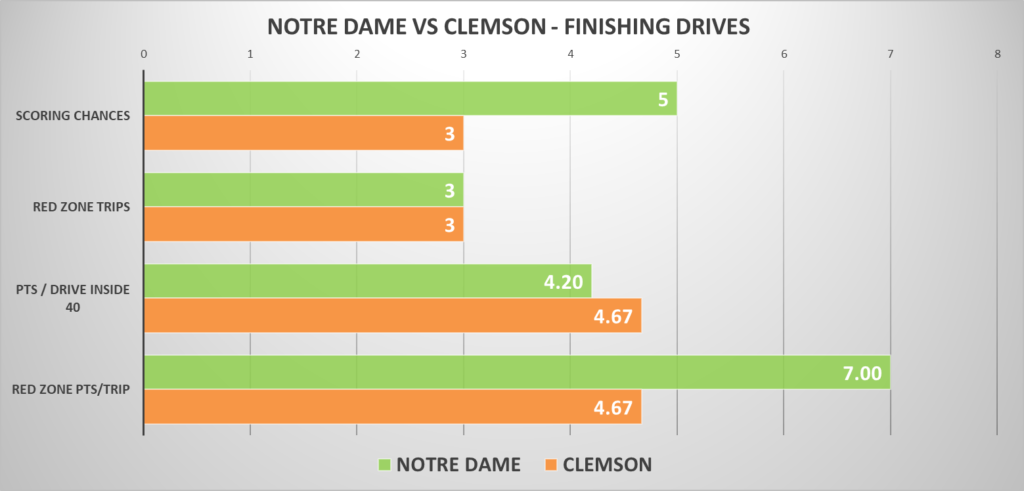
This can’t be a fun season to be a wide receiver at Notre Dame, but those guys blocked their butts off too with the run-heavy attack. Jayden Thomas didn’t put up big numbers but looked like a player who belonged and was thriving on this stage. The Styles drop was one of the few poor offensive plays, and it will be fascinating to see how snaps are distributed at WR the rest of the way – Colzie and Merriweather each ran more plays.
On to a great finish?
As this enormous win wrapped up, there was an understandable immediate reaction to rank and compare this to the best wins of the Brian Kelly era. It’s far more art than science, depending on how much subjective weight you want to put on the true opponent quality, the stakes, and circumstances surrounding the relevant competitors. My advice remains the same as after the Clemson win two years ago – keep this one close and enjoy it.
Regardless of where it stands in your personal rankings, there’s no arguing that this win has a different flavor to it than any of the Kelly era. Unlike many of BK’s biggest wins – 2012 Stanford and Oklahoma, 2020 Clemson – this was a visceral bludgeoning of the opponent. More than any of the Kelly victories, it feels like this could be the start of building something special. If there’s a relative weakness, it’s that there’s less immediate dividends of this win in terms of postseason stakes.
That’s not to diminish this win – this proof of concept is so critical. After the Stanford loss and UNLV win, Notre Dame felt like a program sorely in need of a signature win or two to recapture the preseason momentum of the Freeman era. Two weeks later things are better than our October selves ever imagined. The challenge the rest of November will be avoiding repeating early mistakes and playing down the level of competition against Navy and Boston College. Keep those games drama-free and we’re suddenly looking at a very fun chance to wreak havoc on a big stage at USC and close this regular season in a truly special way.

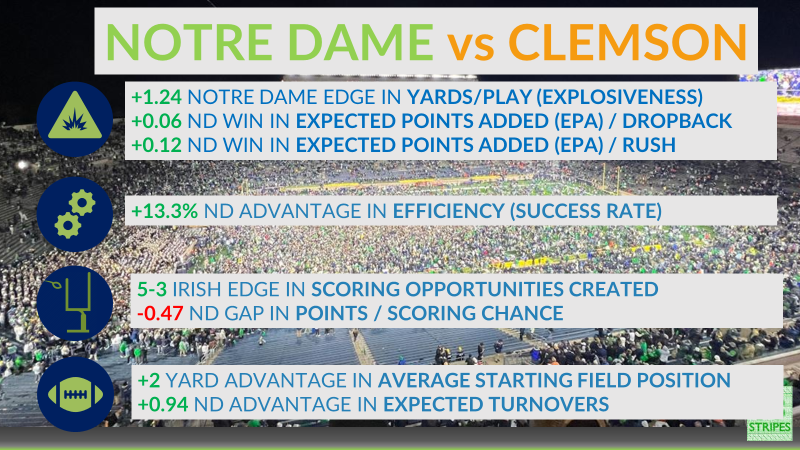
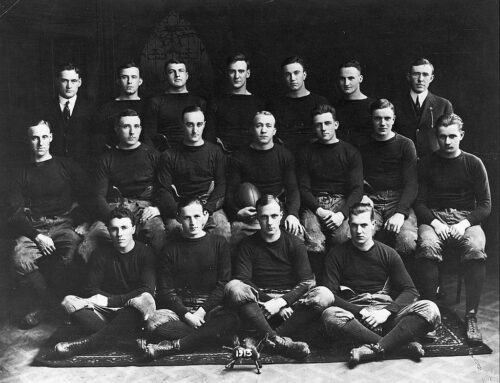


Well put and great look as always. Love that this gives Freeman something to hang his hat on for in-season action. He lost two games that he shouldn’t have, and hopefully that’s the temporary cost of a first time coach who won’t be a first time coach moving forward.
It really was astounding how dominant the o-line was, against such great individuals on the other side as well. Even in 2020, if you take out the very long Kyren run to start the game, the rushing success was fairly limited for the rest of that game.
IF, and it’s a big IF, ND handles the next 2 weeks, and I am controlling 20+ point wins, I will fee very good about nd going out to usc and getting a win. USC just begging to get their ass kicked by a physical team and as eric said yesterday UCLA might just do it the week before.
I was long banging the drum that USC worried me a lot more than Clemson did. Clemson doesn’t pull away from any team with a pulse. But anytime you have a QB that can make plays like this, it’s impressive.
https://twitter.com/ESPNCFB/status/1589114070103457792
But the USC defense is probably worse than even I expected, so who knows. Best case is probably somewhat of a repeat of the UNC game from this year…Though style-wise I highly doubt ND will run ‘n gun as much as they did vs UNC and instead try to control clock and limit possessions. If the RB’s keep getting 4-8 yards on just about literally every carry, it might work too.
Obviously, I like ND’s chances now than I did pre-Clemson, but we shall see. USC’s skill position talent is, as always, quite the challenge.
I mean the talent discrepancy at qb is gonna be huge, every bit as wide as the carolina game, but usc isn’t exactly pulling away from people. I guess their most impressive wins would be what wazzu and fresno st. Even stanford was only a 2 score win and I think usc was like +4 in turnovers. I don’t think the pac12 is much better than the acc. Oregon got wrecked and utah lost to a very average florida team in non conference. Trust me i’m not saying nd would be a reasonable pick against LSU, tennessee, michigan, bama. I just think usc is the right top 12 team to beat. The only team nearly as physical as nd would be utah
Hard to say that 2012 Oklahoma and Stanford didn’t feel like it could be the building of something special. Those games were both literally building towards a NC appearance after a couple mediocre seasons. Also, both OU and Stanford (9th/12th in FEI) were better than this Clemson (21st in FEI).
This, to me, feels more like that Utah game. Dominating a good, but clearly overrated team late in a mediocre ND season, which changes the entire narrative of the season from overmatched new coach to hey, we’ve got something here.
That’s fair, it’s probably a little too much hindsight, but I think there’s a difference between notching a top-5 win in Y1 vs Y3. We will see where Clemson settles, composite rankings using FEI, SP+, FPI, KFord have them 10th at the moment. I think they are wayyyy more highly regarded than that Utah team given the recent success and talent level, even with some clear weaknesses and a hunch that they’d be exposed at some point.
Yeah, definitely more highly regarded, but both were overrated. “Top 5 win” is nice optics, but no one out there actually believes THIS Clemson team is top 5. They are definitely better than ’10 Utah (28th FEI), but we should also be much better than that ’10 ND team as well (27th FEI).
I get why people might compare it OU/Stan, and that’s fine, it’s all just opinion. But there was wayyy more at stake in those games. We aren’t making a playoff this year, and Freeman isn’t getting fired even if he loses that game. The biggest impact from that game is hopefully on recruiting.
I generally think people are overreacting to this win, which is fine and fun and our right as suffering ND fans. Our staff should be acting like it’s the biggest deal ever since marketing is part of their job (to future playoff committees and recruits). But to me this team still makes me nervous. We could easily lose to USC (or one of BC/Navy). Whereas when we beat OU, we were there. We handled Oklahoma in Oklahoma, even if it didn’t turn out to be the best OU team ever.
Just like Stanford didn’t mean this team is a bottom feeder, Clemson doesn’t mean we are now a top 5 team.
My suspicion is that this win really shows just how pitiful the ACC is this year. ND has clobbered the conference’s three allegedly good teams, two of them on the road, and has done so in the same way each time — mercilessly running the ball down their throat and dominating the lines of scrimmage.
The ACC should be nowhere near the playoffs this year.
Maybe they should give a playoff bid to the true ACC champion and team that hasn’t lost a regular season ACC game in like 5 years.
Oklahoma 2012 was a HUGE deal at the time. The idea that ND could beat a top-5 type program on the road at night was unthinkable. That game was the moment that ND turned from a somewhat interesting and lucky team into a serious national title contender for the first time in almost 30 years.
Clemson 2022 could be similar to Utah 2010 in that it was a cathartic game that prevented one season from sliding into disaster. It could also be evidence of a major sea change coming in college football. We shall see.
ISD reporting that CB Karson Hobbs just committed.
Only a 3-star but seems like he could rise. I trust Mickens/Freeman’s eye for CB talent and they wanted him, so that’s good enough for me for now but hopefully they add another elite player. With Morrison, Mickey, the three in the 2023 class, CB is actually looking pretty flush moving forward for Notre Dame, for possibly the first time ever.
Yeah. They seem to have a very good eye for CBs. They also went after Simpson-Hunt when he was still a mid 3 star committed to TTU. Damn, our CB class would have been awesome with him. Alas, he’s now a top 100ish player committed to tOSU.
Would be nice if Hobbs already had a tOSU offer (both because it means he’s good and so they don’t surprise offer him late in the cycle), but they’ve got 6 offers out to top 125 players, so reasonable they might not be as concerned with Hobbs even though he’s an OH kid.
I wouldn’t be worried about OSU regardless. Hobbs’ whole family is huge ND fans.
True. I agree with juice it would be nicer if tOSU wanted him just to validate him a bit more*, but as a private school kid from Cincy it’s not like he’s exactly the standard typical target for them anyways, despite being in-state.
*Then again, even if this were the case like Vernon where they wanted him but he picked ND, a lot of their fans would probably just say he sucked and was over-rated and they didn’t want him anyways, which would also be fun
This note from Jamie Uyeyama is encouraging:
“The defensive backs coach that he originally committed to at South Carolina, Torrian Gray, was the long time DB coach at Virginia Tech when they were “DBU” and he’s been a great evaluator of talent. Mike Mickens has been very good as well. They clearly see a lot of potential with Dobbs and I do as well.”
Yeah. Mickens and Freeman know how to find and develop CBs, that is for sure.